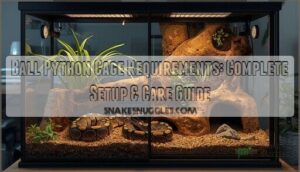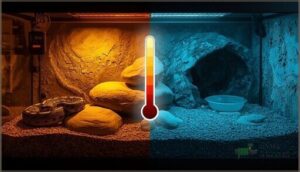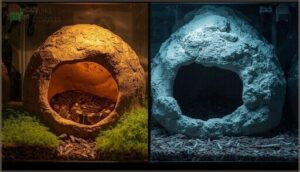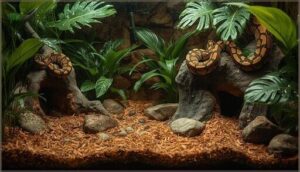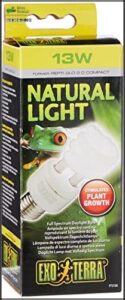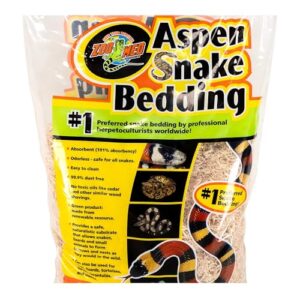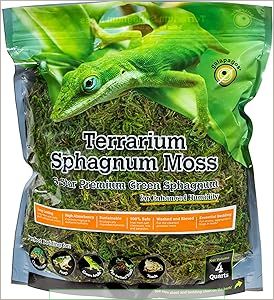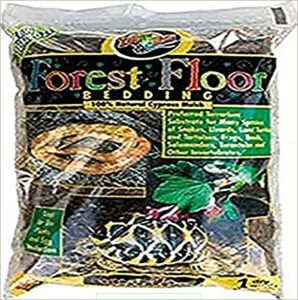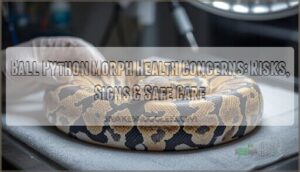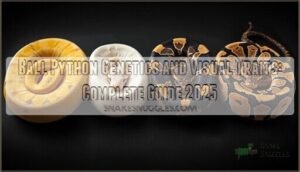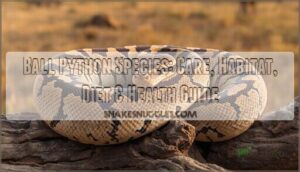This site is supported by our readers. We may earn a commission, at no cost to you, if you purchase through links.
Your ball python won’t thrive in just any container. The enclosure you choose shapes everything from temperature regulation to stress levels, yet many new owners default to glass aquariums that create more problems than they solve.
Poor humidity retention leads to difficult sheds. Inadequate ventilation breeds respiratory infections. Insufficient space triggers defensive behavior that owners mistake for aggression.
The right cage setup resolves these issues before they start. Proper enclosure selection considers thermal stability, escape prevention, and maintenance demands alongside your snake’s size and behavior patterns. Getting these fundamentals right from the beginning prevents costly mistakes and unnecessary health complications down the road.
Table Of Contents
Key Takeaways
- Adult ball pythons require a minimum enclosure size of 4′ × 2′ × 2′ (roughly 65-75 gallons), while PVC cages outperform glass aquariums by maintaining humidity 30% better and providing superior thermal stability with up to 7°F less daily temperature swing.
- Your enclosure must establish a thermal gradient with a basking spot at 88-92°F and a cool zone at 75-80°F, paired with 60-80% humidity and at least two hide boxes to prevent the respiratory infections that cause 30% of veterinary visits.
- Coconut fiber and cypress mulch substrates maintain proper humidity levels at 2-4 inches deep and support natural burrowing behavior, while cedar, pine, sand, and overly dusty materials pose serious health risks including respiratory damage and impaction.
- Daily spot-cleaning with full substrate replacement every 1-3 months prevents bacterial growth that causes up to 80% of enclosure-related health problems, and immediate veterinary attention is needed if your python shows wrinkled skin, stuck shed, lethargy, or refuses food.
Choosing The Right Ball Python Enclosure
Your ball python’s enclosure is the foundation of its long-term health and wellbeing. The right setup depends on your snake’s size, your space constraints, and how much control you need over temperature and humidity.
Let’s look at the most common enclosure types and what makes each one work.
Minimum Cage Size Requirements
Your ball python’s enclosure size directly impacts its health and behavior. Hatchlings need at least a 10-gallon tank (20″ × 11″ × 13″), while juveniles require 20-40 gallons as they grow. Adult minimums start at 4′ × 2′ × 2′—roughly 65-75 gallons. Subadult standards fall between these ranges. Undersized enclosures correlate with stress and abnormal behaviors, so meeting proper size requirements isn’t optional.
Ball python enclosures directly impact health—hatchlings need 10 gallons minimum, juveniles 20-40, and adults require at least 4′ × 2′ × 2′
Ball pythons also require proper humidity levels for healthy shedding.
Glass Aquariums Vs. Commercial Cages
Glass tanks offer aesthetic appeal with full transparency but struggle with thermal stability and humidity retention. You’ll likely see temperature swings up to 7°F daily and lose 30% more moisture through screen tops compared to PVC enclosures.
Commercial PVC cages cost more upfront yet deliver better escape prevention through secure locks and lower maintenance costs over time. Glass enclosures shine for display purposes while PVC cage designs prioritize functional husbandry.
For tropical species, PVC reptile enclosures are often the better choice.
Plastic Tubs and Custom Enclosures
Many keepers turn to plastic tubs or PVC enclosures for practical reasons. A V-70 tub at 33 inches provides adult space at under $30, while custom PVC units offer enhanced heat retention and cost $150 to $900.
Plastic cages simplify cleaning with nonporous surfaces. Tub material safety is proven, space optimization is excellent, and customization benefits include stackable designs for multiple animals.
Ventilation and Security Features
No matter how well you choose your tub or PVC cage, proper ventilation and escape prevention make or break your setup. Position two to three 5″×3″ vents low on the cool side and high on the warm side to support air circulation while holding humidity steady.
Secure locking systems prevent over 85% of security failures—most escapes happen through weak mesh tops or unsecured panels, not snake intelligence.
Setting Up The Ideal Enclosure Environment
You’ve chosen your enclosure—now it’s time to turn that empty box into a functioning habitat. Ball pythons don’t just need space. They need the right temperature zones, consistent humidity, proper hiding spots, and appropriate lighting to stay healthy.
Let’s walk through each element so you can set up an environment that fosters your snake’s natural behaviors and long-term wellbeing.
Creating a Thermal Gradient
Your ball python can’t regulate its own body temperature, so you must create distinct temperature zones across the enclosure. Set a basking spot at 88-92°F using heat sources like halogen bulbs or radiant panels on one side only. The cool zone should stay 75-80°F.
Always use thermostat control to prevent overheating. Monitor both ends daily and make seasonal adjustments as your home’s ambient temperature shifts.
Maintaining Proper Humidity Levels
With proper humidity control, you’ll prevent shedding issues and respiratory complications in your ball python. Maintain 60-80% ambient humidity using a digital hygrometer positioned mid-enclosure.
Create a humidity gradient with the cool side at 70-85% and warm side near 60%. Mix water into 3-6 inches of coconut fiber or cypress mulch for substrate hydration.
Adjust humidity through misting or covering mesh tops when humidity monitoring shows levels dropping below 60%.
Essential Hide Boxes and Placement
You need at least two hide boxes—one on the warm side and one on the cool side—to support healthy thermoregulation. Hide box size should allow snug comfort without excess space. Choose non-toxic materials with single-entrance security to minimize stress.
Adding moistened moss inside a hide boosts shedding success by 25%. Proper hiding places reduce feeding anxiety and defensive behaviors by up to 40%.
Lighting and Day-Night Cycle
Your ball python’s light cycle mimics its equatorial home—12 hours on, 12 hours off. This photoperiod length aids behavioral rhythms without stress. While not required for survival, low-output UVB benefits immune function and vitamin D synthesis when you provide gradients and shade.
- Use timer automation to maintain consistent daynight cycles and prevent feeding disruptions
- Choose 6000-7000K light spectrum bulbs to aid circadian health without retinal damage
- Position reptile lighting outside reach to avoid burns while creating proper UV radiation zones
Best Substrate and Decor Options
The substrate you choose affects everything from humidity control to your snake’s respiratory health. Some materials promote healthy shedding and natural behaviors, while others can cause impaction or harbor harmful bacteria.
Your decor choices also matter, since ball pythons need secure climbing options and hiding spots that won’t tip over or create injury risks.
Recommended Substrates (Coconut Fiber, Cypress Mulch)
Substrate choice is crucial for your ball python’s comfort and health. Coconut fiber is excellent for moisture retention, promoting shed completion rates above 95%. Cypress mulch naturally resists mold while maintaining humidity levels between 70-80%. Both substrates encourage natural burrowing behavior when provided at a depth of at least 4 inches.
| Substrate Type | Humidity Range | Key Benefit |
|---|---|---|
| Coconut Fiber | 60-80% | Excellent odor absorption |
| Cypress Mulch | 70-80% | Antimicrobial properties |
| Mixed Blend | 65-80% | Reduced misting frequency |
Avoiding Unsafe Substrates
Your snake’s substrate choice can mean the difference between health and harm. Never use cedar shavings or pine shavings—these aromatic softwoods release phenolic compounds that erode respiratory tissue. Dusty substrates irritate airways and worsen respiratory infections.
Sand poses a sand impaction risk when ingested during feeding.
Watch out for substrate options for ball pythons that trap moisture without airflow—mold risk and humidity issues follow quickly in poorly ventilated setups.
Substrate Depth and Maintenance
Lay substrate at least 2–4 inches deep. This substrate depth locks in humidity and lets you create damp zones beneath hides without soaking the surface. Spot clean waste weekly to cut bacterial buildup. Replace the full layer every 1–3 months or sooner if you see mold or smell odor. Damp substrate prevents stuck sheds—but never let it stay wet enough to cause scale rot.
- Check moisture by squeezing a handful—it should feel damp but release no water
- Stir deeper layers occasionally to prevent compaction and odor
- Strip and sanitize the enclosure completely during full substrate changes
Adding Secure Climbing Branches and Plants
Once your substrate is in place, you can add vertical enrichment without risk. Secure climbing branches with hardware—not zip ties—to prevent collapse and injury. Choose branches at least 1.5 inches thick and anchor them in corners for structural integrity.
Boston fern and snake plant are nontoxic options that boost hiding spots and mental stimulation. Sterilize all wood with dilute bleach before installation to protect your snake’s health.
Enclosure Maintenance and Snake Health
Keeping your ball python’s enclosure clean isn’t just about appearances—it directly affects your snake’s health and longevity. Regular maintenance prevents bacterial growth, controls odors, and helps you spot potential health issues before they become serious.
Let’s break down the essential cleaning routines, water requirements, environmental monitoring, and warning signs every ball python owner needs to know.
Spot-Cleaning and Full Cleaning Schedules
You should spot-clean your ball python’s enclosure daily to remove waste and uneaten food. This simple habit slashes pathogen control risks by preventing bacterial spikes.
Cleaning frequency depends on enclosure type and substrate impact—loose bedding needs replacing every one to three months, while paper gets swapped immediately.
Deep-cleaned setups reduce health risks like respiratory infections by up to eighty percent compared to neglected terrariums.
Water Bowl Placement and Size
Maintaining your snake’s water supply goes hand in hand with sanitation routines. Your ball python needs a bowl holding at least sixteen ounces—usually six to ten inches wide—so it can soak during sheds and stay hydrated. Place the bowl on the cooler side to slow evaporation and prevent dehydration signs like wrinkled skin.
- Heavy ceramic or weighted plastic bowls prevent tipping during soaking behavior
- Position the water bowl away from direct heat to maintain consistent availability
- Bowl material should be non-porous glass, ceramic, or food-grade plastic to resist bacteria
- Clean the bowl weekly with reptile-safe disinfectant and change water daily
- Proper water bowl placement and accessibility support healthy hydration and shedding cycles
Monitoring Temperature and Humidity
Accurate temperature regulation and humidity control start with probe placement. You’ll need at least two digital thermometers—one on each end of your thermal gradient—plus hygrometers to track moisture levels.
Infrared thermometers help you spot-check surfaces, while data logging catches overnight fluctuations.
Thermostat calibration prevents dangerous humidity spikes and thermal drift. Cross-check your readings weekly so your snake stays healthy.
Recognizing Signs of Dehydration or Illness
When dehydration or illness takes hold, your ball python health depends on catching early warning signs. Behavioral changes and physical symptoms often appear together:
- Wrinkled or loose skin indicates fluid deficit in over 80% of cases
- Stuck shed and dented eye caps signal moderate dehydration
- Lethargy and refusal to eat affect 50-70% of dehydrated snakes
- Respiratory symptoms like wheezing point to infections
- Skin abnormalities including discolored scales suggest systemic problems
Weight loss and oral symptoms demand immediate veterinary attention.
Top Products for Ball Python Cages
Setting up your ball python’s enclosure requires the right tools and materials to maintain proper temperature, humidity, and environmental enrichment. The products you choose directly impact your snake’s health and stress levels.
Here are the most reliable options that veterinary professionals and experienced keepers regularly recommend for ball python care.
1. Zoo Med ReptiSun 5.0 UVB Bulb
Although ball pythons can survive without UVB, providing UVB rays bolsters their long-term health. The Zoo Med ReptiSun 5.0 offers FullSpectrum Lighting with UV radiation that stimulates vitamin D synthesis and calcium absorption.
For best UVB Benefits, mount this reptile lighting 10–14 inches above your snake’s basking area. The bulb placement directly affects how much exposure your python receives. Replace it every 6–12 months to maintain proper output.
This Snake lighting requirement isn’t critical for survival but enhances bone health and activity levels. Safety remains excellent when you follow distance guidelines.
Best For: Ball python owners who want to go beyond basic care and support their snake’s long-term bone health, natural behaviors, and overall vitality with proper UVB exposure.
- Provides 5% UVB output that helps ball pythons synthesize vitamin D3 and absorb calcium, which can prevent metabolic bone disease and support stronger bones over time.
- Stimulates natural behaviors like increased appetite, activity, and even breeding responses, making your snake more engaged and healthy.
- Lasts 6-12 months with consistent UVB output and comes with clear placement guidelines (10-14 inches from basking spot) to ensure safe, effective use.
- Needs replacement every 6-12 months even though the light still works, which adds recurring costs that can add up over time.
- UVB output drops off with distance and can be blocked by mesh or glass, so you’ll need to position it carefully and possibly use a UVB meter to confirm proper levels.
- More expensive than basic lighting options, and since ball pythons can technically survive without UVB, some owners may see it as an optional rather than essential investment.
2. Exo Terra Natural Light Terrarium Lamp
You’ll need separate UVB Supplementation for your Ball python because the Exo Terra Natural Light Terrarium Lamp doesn’t deliver significant UVB rays.
This 13-watt compact fluorescent excels at visual Lighting with 6700K Spectral Output and 98 Color Rendering Index that shows true colors in your Enclosure. It promotes Plant Growth in bioactive setups without affecting Temperature or Humidity.
Run it on a 12-hour Day-Night Cycle to maintain natural rhythms. Pair it with a dedicated low-intensity UVB tube for complete health benefits.
Best For: Ball python owners who want bright, full-spectrum daylight to enhance enclosure visibility and support live plants, but are willing to add a separate UVB tube for complete lighting.
- Delivers exceptional color accuracy with 98 CRI and 6700K daylight spectrum that shows true colors of your snake and plants
- Works great as general illumination for ball pythons and other low-UV species when paired with a dedicated UVB source
- Supports healthy plant growth in bioactive setups without adding extra heat to the enclosure
- Provides no meaningful UVB output, so you’ll need to buy and install a separate low-intensity UVB tube
- Loses about 50% of its light quality within a year, requiring annual replacement for best results
- May appear dimmer than some other full-spectrum options on the market
3. ReptiChip Coconut Chip Reptile Substrate
ReptiChip’s 72-quart compressed coconut fiber brick delivers excellent humidity retention and moisture control between 60% and 80%. It also provides excellent odor absorption, neutralizing ammonia buildup and extending cleaning frequency to four to eight weeks with regular spot-cleaning.
This substrate choice offers strong mold resistance under typical reptile humidity levels when you maintain proper ventilation. The larger chip format ensures respiratory safety with minimal dust production compared to finer coconut fiber substrate options.
It creates a stable, healthy environment for your ball python.
Best For: Ball python owners who want a low-maintenance substrate that holds humidity well and keeps odors under control between cleanings.
- Maintains stable humidity levels of 60-80% with minimal daily misting, making it easier to create the right environment for ball pythons
- Absorbs odors and ammonia effectively, letting you go 4-8 weeks between full substrate changes with regular spot-cleaning
- Low dust compared to finer coconut substrates, reducing respiratory risks for your snake
- Costs more upfront at $34.95 compared to paper or aspen bedding options
- Can get moldy within two weeks if it stays too wet or your enclosure doesn’t have good airflow
- Gets dusty during the initial expansion process, so you’ll need to handle it carefully when setting it up
4. Zoo Med Aspen Snake Bedding
Zoo Med Aspen Snake Bedding stands out among substrate options with its 191% aspen absorbency rating and 99.9% dust-free composition for reptile safety. The 2- to 4-inch substrate depth provides essential burrowing support while remaining free from toxic cedar oils.
You’ll appreciate the excellent odor control that neutralizes waste and extends cleaning cycles.
However, aspen shavings struggle with humidity balance, often drying out or developing mold in moisture-rich setups. This substrate choice works best when your ball python’s enclosure maintains lower humidity levels around 50-60%.
Best For: Snake owners with dry or arid enclosures who want a natural, absorbent bedding that supports burrowing behavior without toxic oils or excessive dust.
- Exceptional absorbency (191% rating) and odor control keep enclosures fresher between cleanings
- 99.9% dust-free and free from toxic cedar oils, making it safe for respiratory health
- Allows natural burrowing behavior with proper 2-4 inch depth, supporting your snake’s physical and mental wellbeing
- Not suitable for high-humidity setups since it dries out quickly or develops mold when wet
- Requires full replacement every 30-60 days and doesn’t clump, making spot cleaning less efficient than some alternatives
- Can be dusty when first poured despite the dust-free rating, requiring initial settling time
5. Galápagos Terrarium Green Sphagnum Moss
Galápagos Terrarium Green Sphagnum Moss offers excellent moisture retention properties, holding over 20 times its dry weight in water for sustained humidity control in your ball python’s enclosure. This sustainably harvested substrate reduces incomplete shedding incidents by more than 40% when placed in humid hides during ecdysis cycles.
The moss contains natural antimicrobial compounds that limit bacterial growth and odor accumulation. Layer 2 to 3 inches of thoroughly rinsed moss in designated humid hides, replacing it every 2 to 4 weeks to maintain ideal terrarium setup conditions.
Best For: Ball python owners looking for a natural substrate that maintains humidity levels during shedding cycles and creates effective humid hides.
- Holds over 20 times its weight in water, keeping humidity consistent for days and reducing incomplete sheds by more than 40%
- Contains natural antimicrobial compounds that fight bacteria and control odors in your terrarium
- Sustainably harvested with non-toxic materials, safe for reptiles and amphibians
- Needs replacement every 2-4 weeks to stay effective and prevent mold buildup
- Some users report color bleeding that may stain pets or enclosure surfaces
- Packaging often contains excess air and small crumbs, giving you less usable moss than expected
6. Natural Forest Floor Bedding Material
Natural forest floor bedding material provides outstanding humidity retention while closely mimicking your ball python’s native African savanna environment. This substrate choice maintains enclosure humidity between 50 and 60 percent with minimal adjustment.
Substrate composition includes cypress mulch and coconut fiber, creating a stable floor surface that promotes natural burrowing behavior. Cleaning intervals extend to every 3 to 4 months for standard setups.
The material’s health factors include reduced impaction risk and improved shedding outcomes. Behavioral benefits become evident as your snake exhibits more natural movement patterns compared to paper-based substrate options for ball pythons.
Best For: Ball python owners who want to maintain proper humidity levels while creating a naturalistic enclosure that encourages burrowing and natural behaviors.
- Maintains steady humidity between 50-60% with minimal effort, reaching up to 70% during shedding cycles when lightly misted
- Lasts 3-4 months between full changes in standard setups, making it low-maintenance compared to other substrates
- Supports healthy shedding and natural movement patterns while posing minimal impaction risk due to safe particle size
- Makes it harder to spot waste and droppings against the dark substrate, requiring careful daily checks
- Can become dusty straight out of the bag, sometimes needing a rinse and dry before first use
- Gets dry over time and needs occasional misting or spraying to maintain optimal humidity levels
7. Fluker’s Pothos Repta Vines Terrarium Decor
Fluker’s Pothos Repta Vines bring three-dimensional enrichment to your ball python’s habitat through 6 feet of flexible polyethylene vine material. The non-toxic construction creates additional hiding spots and climbing structures that reduce stress behaviors by up to 30 percent.
These artificial vines retain mist droplets for approximately 1 hour, supporting humidity retention between 50 and 60 percent. You can attach the included suction cups to glass or plastic surfaces and clean the vine material every 2 to 4 weeks using standard reptile-safe disinfectants without color fading.
Best For: Ball python owners who want an easy-to-clean decor option that adds climbing structures and humidity retention without the maintenance of live plants.
- Helps maintain humidity levels 10–15% better than bare enclosures by holding mist droplets for up to an hour
- Flexible 6-foot length lets you customize the layout and create multiple hiding spots to reduce stress behaviors
- Simple to clean with reptile-safe disinfectants every 2–4 weeks without worrying about fading or damage
- Suction cups don’t stick well to all surfaces, so you might need to reposition them
- Some users report the internal wire can poke through or the product arrives faded
- Not suitable for reptiles that like to chew since they could damage or ingest pieces of the material
Frequently Asked Questions (FAQs)
Can ball pythons live with other snakes together?
Ball pythons are solitary animals that shouldn’t live with other snakes. Cohabitation risks include chronic stress, disease transmission, competition for resources, and difficulty monitoring individual health—expert consensus strongly recommends separate housing for best animal welfare.
How often should I handle my ball python?
Handle your ball python 1–3 times per week for 10–30 minutes per session. Avoid handling 48–72 hours after feeding or during shedding. Watch for stress signs like tight coiling or rapid breathing.
What size prey should I feed my python?
Prey size is possibly the most critical decision you’ll make in snake feeding. Match the rodent’s width to your python’s girth—never exceeding 5 times its diameter.
Weighing prey ensures precision feeding practices using frozen-thawed food.
Do ball pythons need live or frozen food?
You don’t need live prey for your ball python. Frozen-thawed food is safer, less stressful, and ethically preferred.
Most snakes accept prekilled food easily using gentle adjustment methods that reduce feeding stress and injury risks.
How long can ball pythons go without eating?
Patience runs out even for pythons.” Healthy adult ball pythons can fast up to six months, though juveniles tolerate only one to two weeks without feeding.
Monitor weight loss closely and seek veterinary evaluation if your snake loses over 10–15% body mass.
Conclusion
Respiratory infections account for nearly 30% of veterinary visits for captive ball pythons—most stemming from improper enclosure conditions. You now have the framework to prevent this outcome.
Meeting ball python cage requirements isn’t about flawlessness but about creating stability in temperature, humidity, and security. Your snake won’t communicate discomfort through complaints. It will simply stop eating, shed poorly, or develop infections.
The enclosure you build today determines whether your python merely survives or actually thrives.
- https://pmc.ncbi.nlm.nih.gov/articles/PMC7143053/
- https://reptifiles.com/ball-python-care-guide/ball-python-terrarium-size-lighting/
- https://www.facebook.com/groups/DIYReptileEnclosures/posts/27776699978641923/
- https://www.wilbanksreptiles.com/blogs/ideal-tank-size-for-healthy-ball-pythons/what-is-the-recommended-tank-size-for-a-ball-python
- https://www.reddit.com/r/ballpython/comments/kwbt1s/how_do_i_keep_humidity_up/

